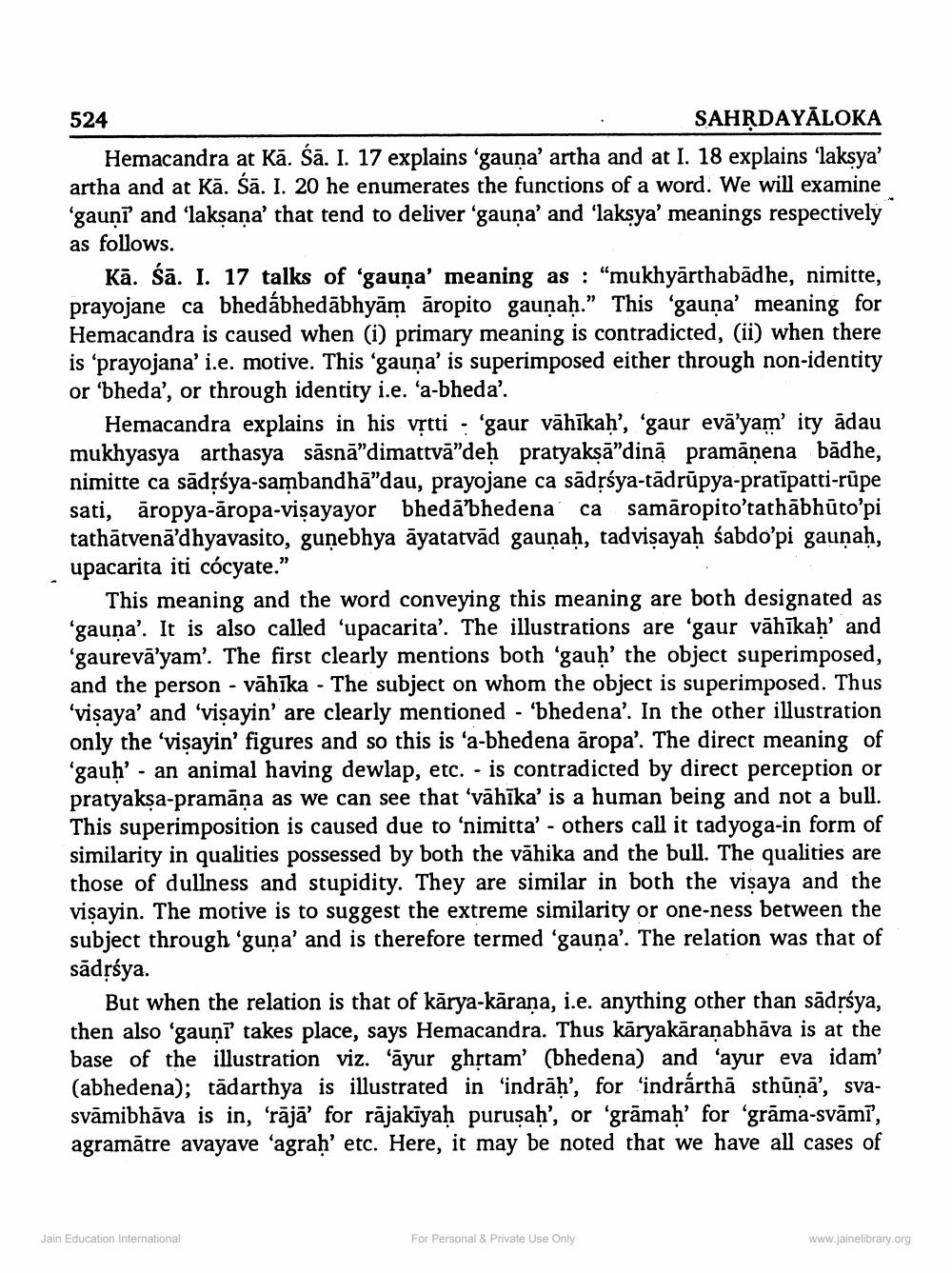________________
524
SAHĶDAYĀLOKA Hemacandra at Kā. Šā. I. 17 explains 'gauna' artha and at I. 18 explains 'laksya' artha and at Kā. Sā. I. 20 he enumerates the functions of a word. We will examine 'gaunī and 'laksana' that tend to deliver 'gauna' and 'laksya' meanings respectively as follows.
Kā. Šā. I. 17 talks of 'gauņa' meaning as : “mukhyārthabādhe, nimitte, prayojane ca bhedábhedābhyām āropito gaunaḥ.” This 'gauna' meaning for Hemacandra is caused when (i) primary meaning is contradicted, (ii) when there is 'prayojana' i.e. motive. This 'gauna' is superimposed either through non-identity or 'bheda', or through identity i.e. ‘a-bheda'.
Hemacandra explains in his vịtti gaur vāhīkah', 'gaur evā’yamity adau mukhyasya arthasya sāsnā”dimattvā”deḥ pratyaksā”dinā pramāṇena bādhe, nimitte ca sādrśya-sambandhā”dau, prayojane ca sādrśya-tādrūpya-pratīpatti-rūpe sati, āropya-āropa-visayayor bhedā bhedena ca samāropito'tathābhūto'pi tathātvenā’dhyavasito, gunebhya āyatatvād gauņaḥ, tadvisayaḥ śabdo’pi gaunaḥ, upacarita iti cocyate.”
This meaning and the word conveying this meaning are both designated as 'gauna'. It is also called 'upacarita'. The illustrations are 'gaur vāhīkah' and 'gaurevā'yam. The first clearly mentions both 'gauḥ' the object superimposed, and the person - vāhīka - The subject on whom the object is superimposed. Thus 'visaya' and 'visayin' are clearly mentioned - 'bhedena'. In the other illustration only the 'vişayin' figures and so this is 'a-bhedena äropa'. The direct meaning of 'gauh' - an animal having dewlap, etc. - is contradicted by direct perception or pratyaksa-pramāna as we can see that 'vāhīka' is a human being and not a bull. This superimposition is caused due to ‘nimitta' - others call it tadyoga-in form of similarity in qualities possessed by both the vāhika and the bull. The qualities are those of dullness and stupidity. They are similar in both the visaya and the visayin. The motive is to suggest the extreme similarity or one-ness between the subject through 'guna' and is therefore termed 'gauna'. The relation was that of sādņśya.
But when the relation is that of kārya-kārana, i.e. anything other than sādrśya, then also 'gauņī takes place, says Hemacandra. Thus kāryakāraṇabhāva is at the base of the illustration viz. 'āyur ghrtam' (bhedena) and ‘ayur eva idam' (abhedena); tādarthya is illustrated in 'indrāḥ', for ‘indrárthā sthūna', svasvāmibhāva is in, 'rājā for rājakiyaḥ puruṣaḥ, or 'grāmaḥ' for 'grāma-svāmī, agramātre avayave 'agrah' etc. Here, it may be noted that we have all cases of
Jain Education International
For Personal & Private Use Only
www.jainelibrary.org




